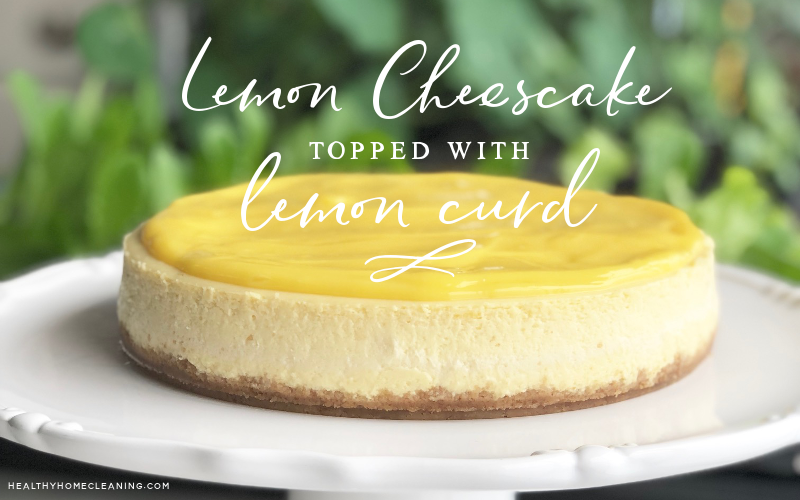
Lemon Cheesecake is the perfect dessert!
It is delightful & decadent in every way but also bright and fresh without being overly heavy.
For years, I avoided making cheesecake because I believed it was just too hard to make a good one. I thought only the most skilled bakers could pull off the impressive feat of creating the perfect cheesecake. But cheesecake baking (and subsequently, eating) should NEVER be a source of worry or distress. It should only ever be pure joy.
Lemon Cheesecake topped with Lemon Curd
Making cheesecake can’t be an impulse decision – it takes a little planning- like 2 days ahead of the time you want to eat it.
You should always use room-temperature ingredients. I can’t stress this enough.
The night before you want to bake your lemon cheesecake, remove your cream cheese and eggs from the fridge so that by the time you mix up the batter, the cheese will be soft and cream-able, and your eggs will smoothly incorporate into the batter.
Now, onto the baking!
Preheat your oven to 350° F.
Coat the inside of an 8 or 9-inch springform pan with butter. You can use your fingers and a little pat of butter, but I find it easiest just to grab the block of butter and rub it all over the bottom and sides of the pan.
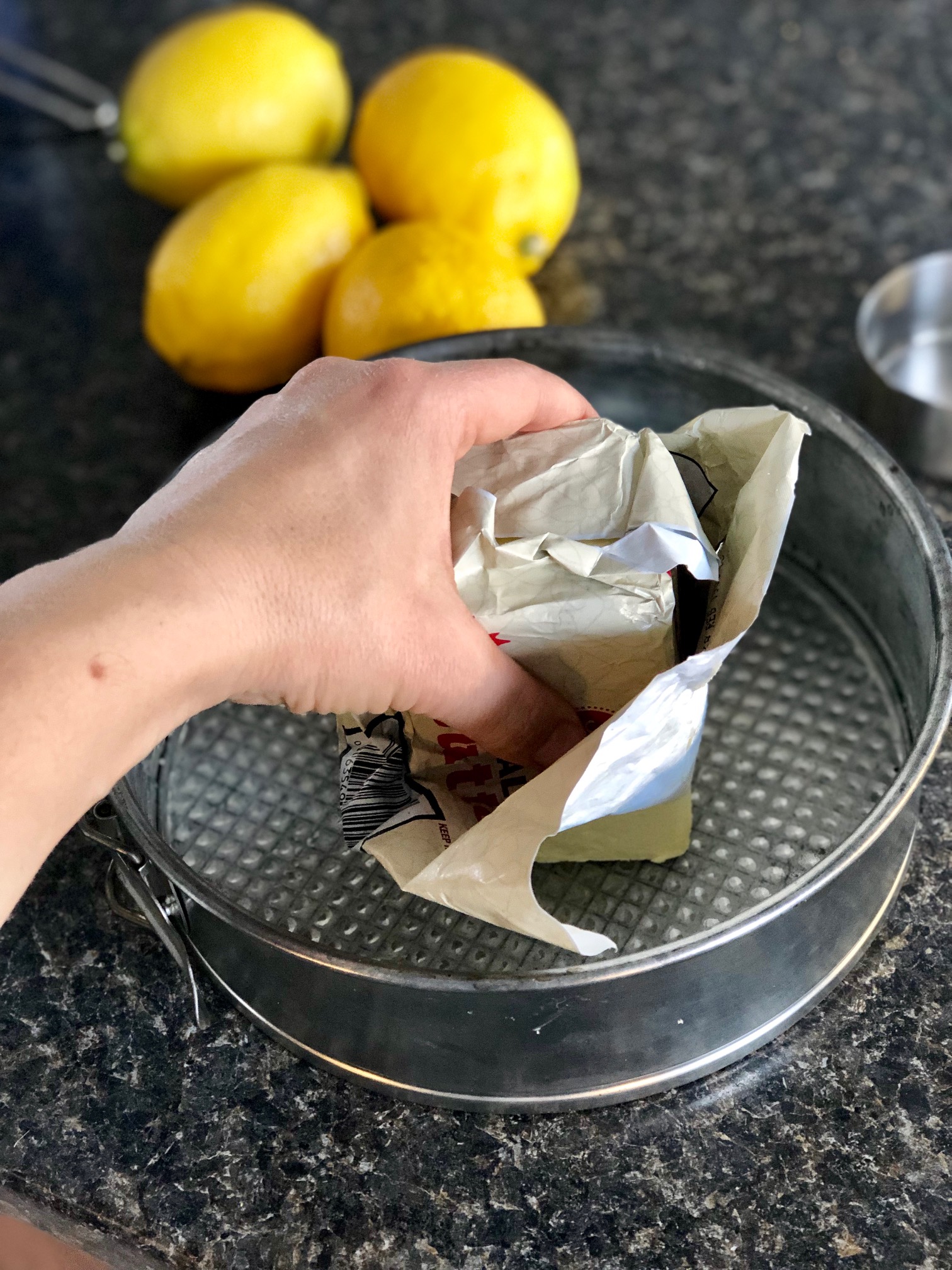
The Crust
To make the crust, combine the graham cracker crumbs (12 whole graham crackers or 6 oz) and melted butter (5 Tbsp) in a bowl. The mixture should have the texture of wet sand and hold together when you squeeze it in your fist.
For a gluten-free cheesecake, use gluten-free graham crumbs.
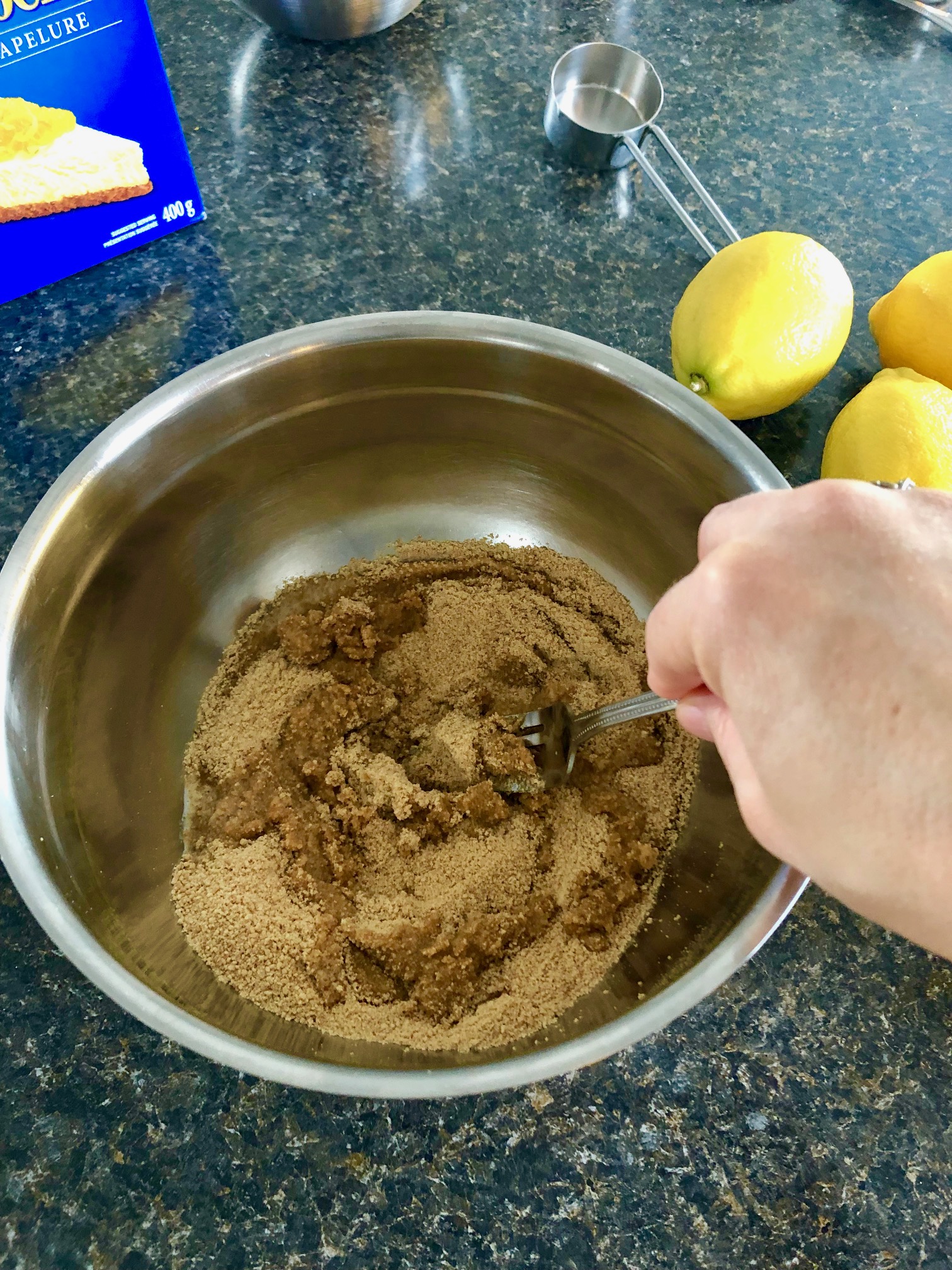
Transfer the mixture to the greased springform pan.

Very firmly, press the crumb mixture evenly into the bottom of the pan, using either your hands or the bottom of a drinking glass.
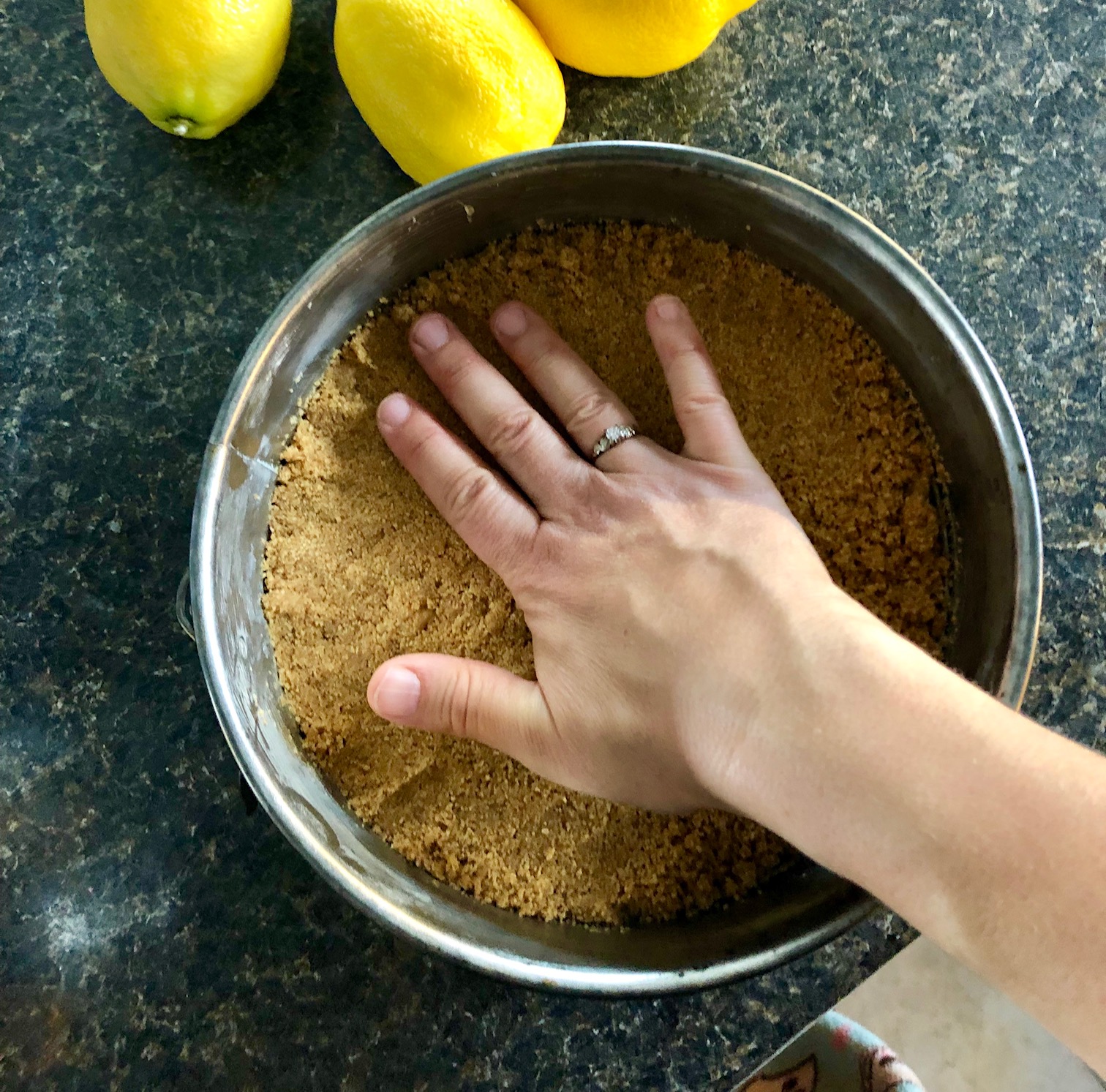
Wrap it in tinfoil.
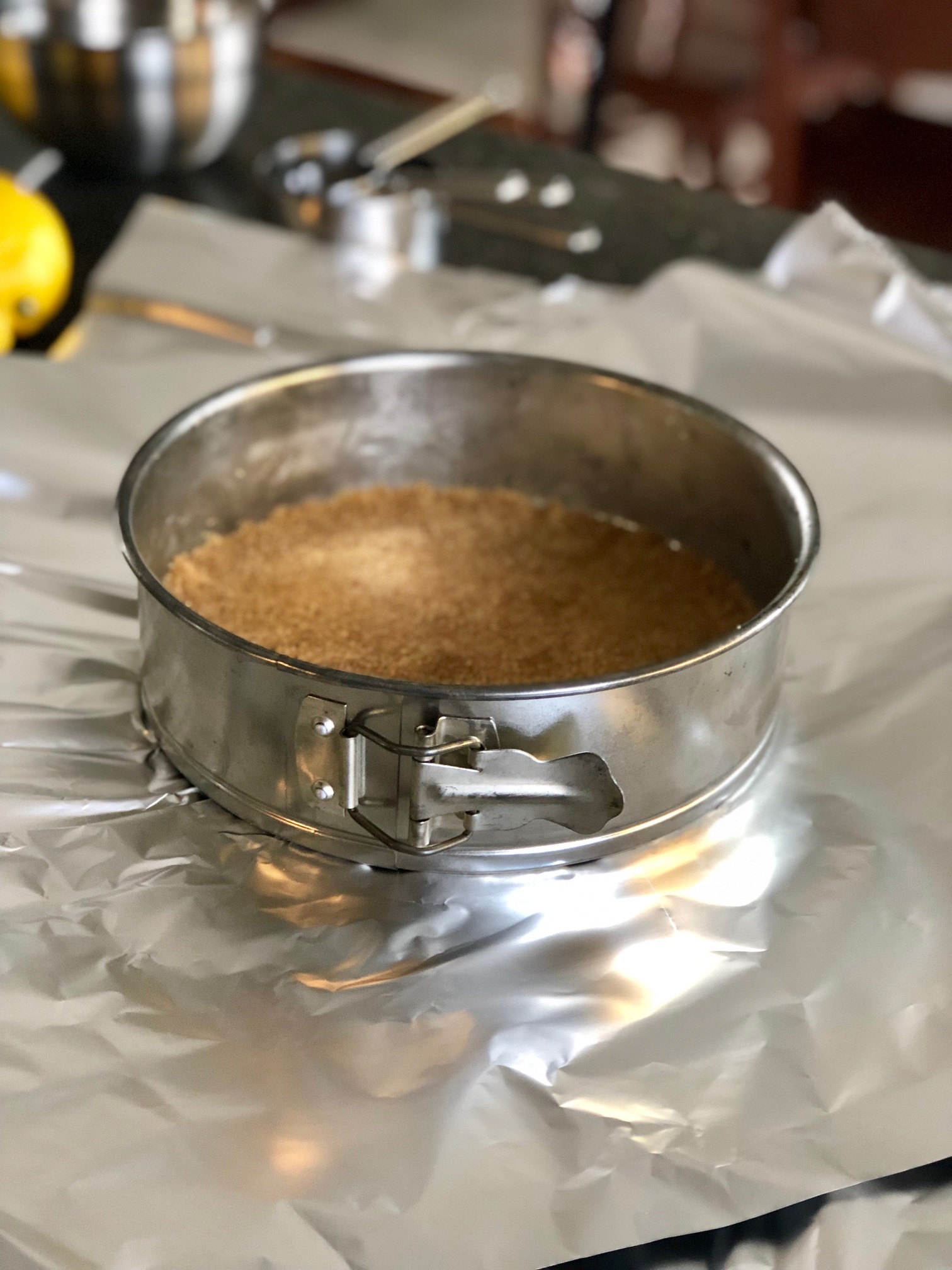
The cheesecake will be baked in a water bath (which is not complicated), so to prevent water from getting into the pan, we will wrap it up like a shiny present.
If you have heavy-duty barbecue tinfoil, this is the time to use it. If not, regular tinfoil will work just fine.
Cut 2 large pieces of tinfoil and set them on your work surface, one on top of the other in a cross. Set the springform pan in the middle of the foil and wrap the foil up and around the sides of the pan.
PRO TIP: Seal the top of the foil as tightly as you can around the top; this helps prevent condensation from forming between the pan and foil and damping your crust.
Place the crust in the oven (preheated to 350°) and bake until it’s fragrant and just getting golden around the edges, about 8-10 minutes.
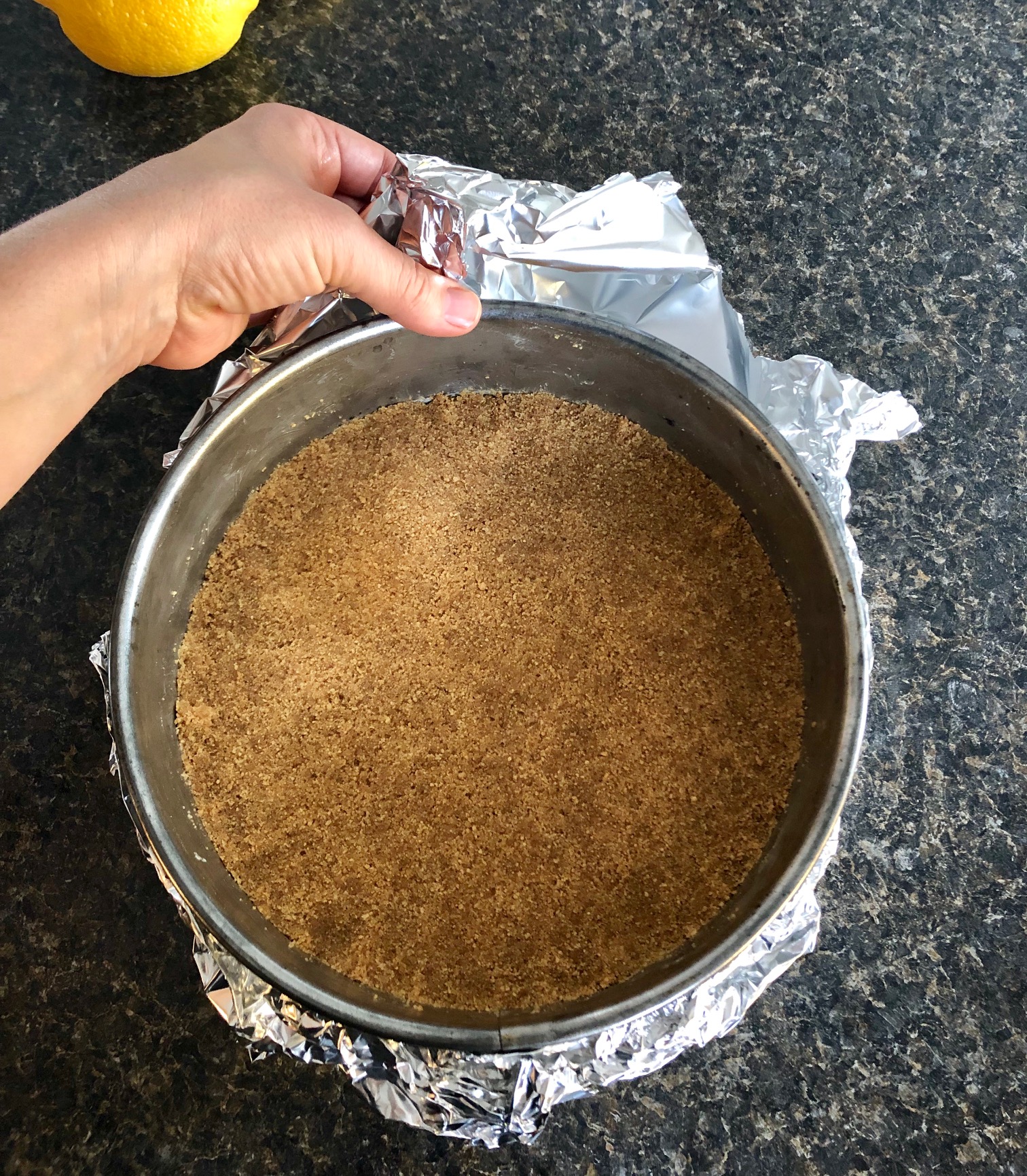
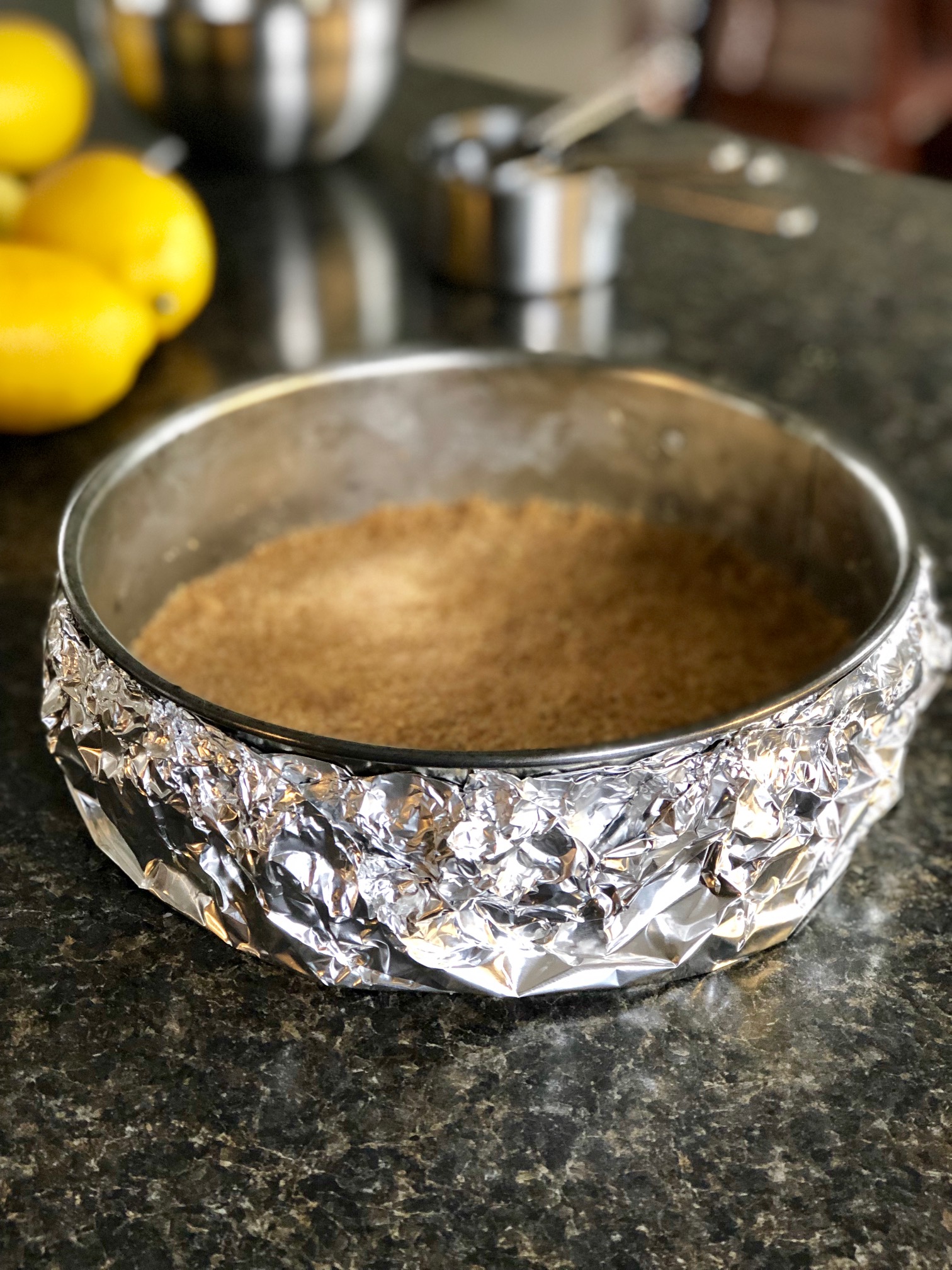
Remove from the oven to a cooling rack and let it cool while you prepare the filling.
The Lemon Cheesecake Filling
Place the softened cream cheese, sugar, salt, and cornstarch (or flour) in the bowl of your mixer fitted with the paddle attachment (alternatively, you can use a hand-held electric mixer and a large bowl).
Why use cornstarch or flour, you ask? Both of these ingredients act as a binding agent and will prevent your cheesecake from forming cracks! But don’t worry – it won’t change the taste or texture of your cheesecake.
Cornstarch is more powerful, so if you use it, you’ll only need half as much flour as you would flour.
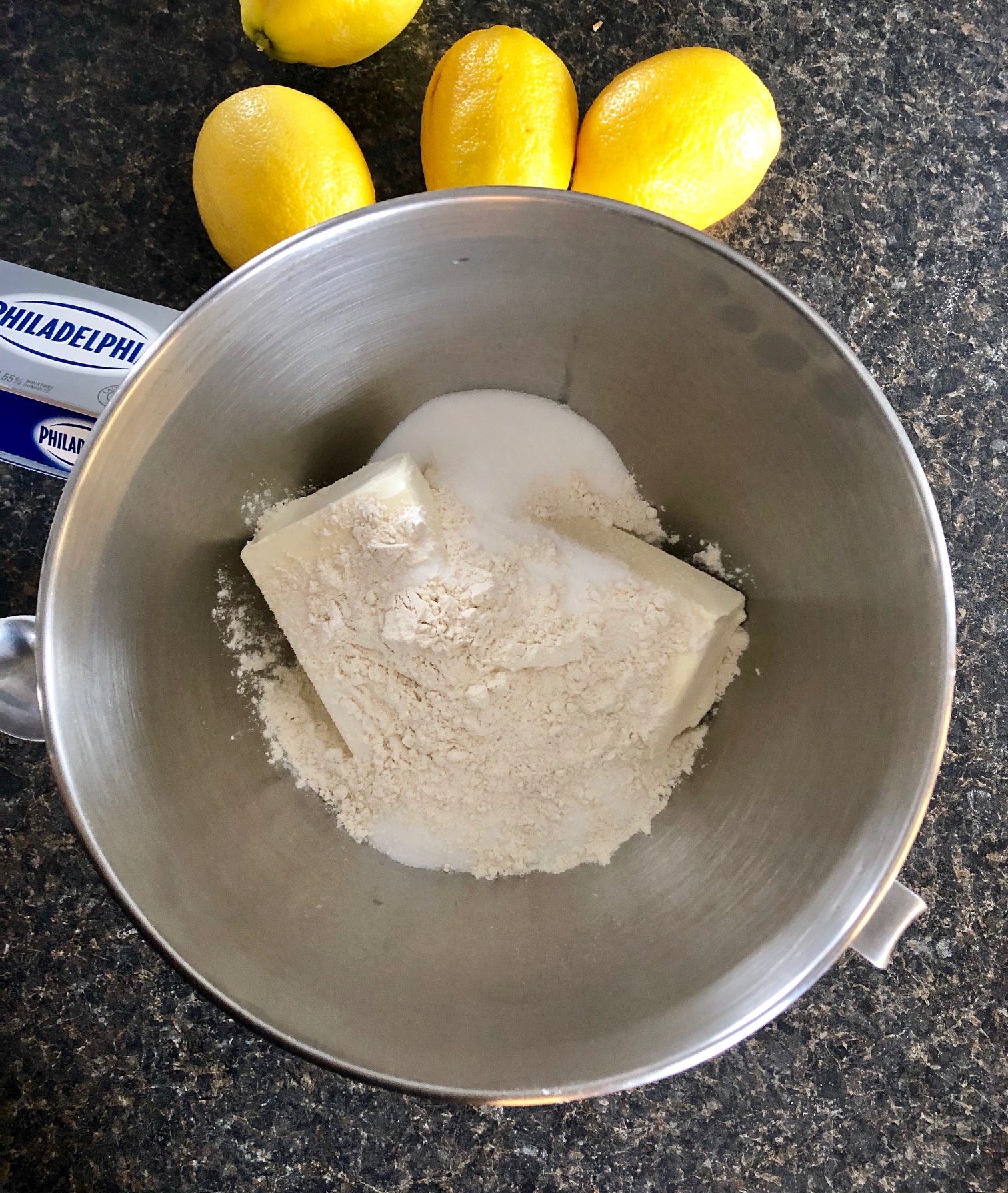
On medium-low speed (NOT high), cream the ingredients until creamy and silky and no lumps of cream cheese remain. Use a spatula to scrape down the bowl’s edges, ensuring everything is well incorporated.
Do not mix on high-speed.
With cakes and cookies, the goal is to incorporate air into the fat-sugar combination by having your mixer turned to high, to create light and fluffy confections. With cheesecake, however, the opposite is true; the goal for a cheesecake is dense and creamy. If you incorporate too much air into the batter while mixing, the cheesecake tends to puff up and fall during baking, causing cratering & cracking.

Meanwhile, zest & juice 2 lemons. You should use all of the zest from the lemons and 6 Tbsp of the lemon juice. You may need 3 to collect enough juice if the lemons are small.
I don’t have a citrus juicer so I have to squeeze the lemons by hand. If you’re in the same boat as me, squeeze them over your other hand; the juice goes through your fingers, and the seeds get caught! It’s also wise to carefully inspect the collected juice; lemons have itty bitty seeds that can sneak through the finger trap.
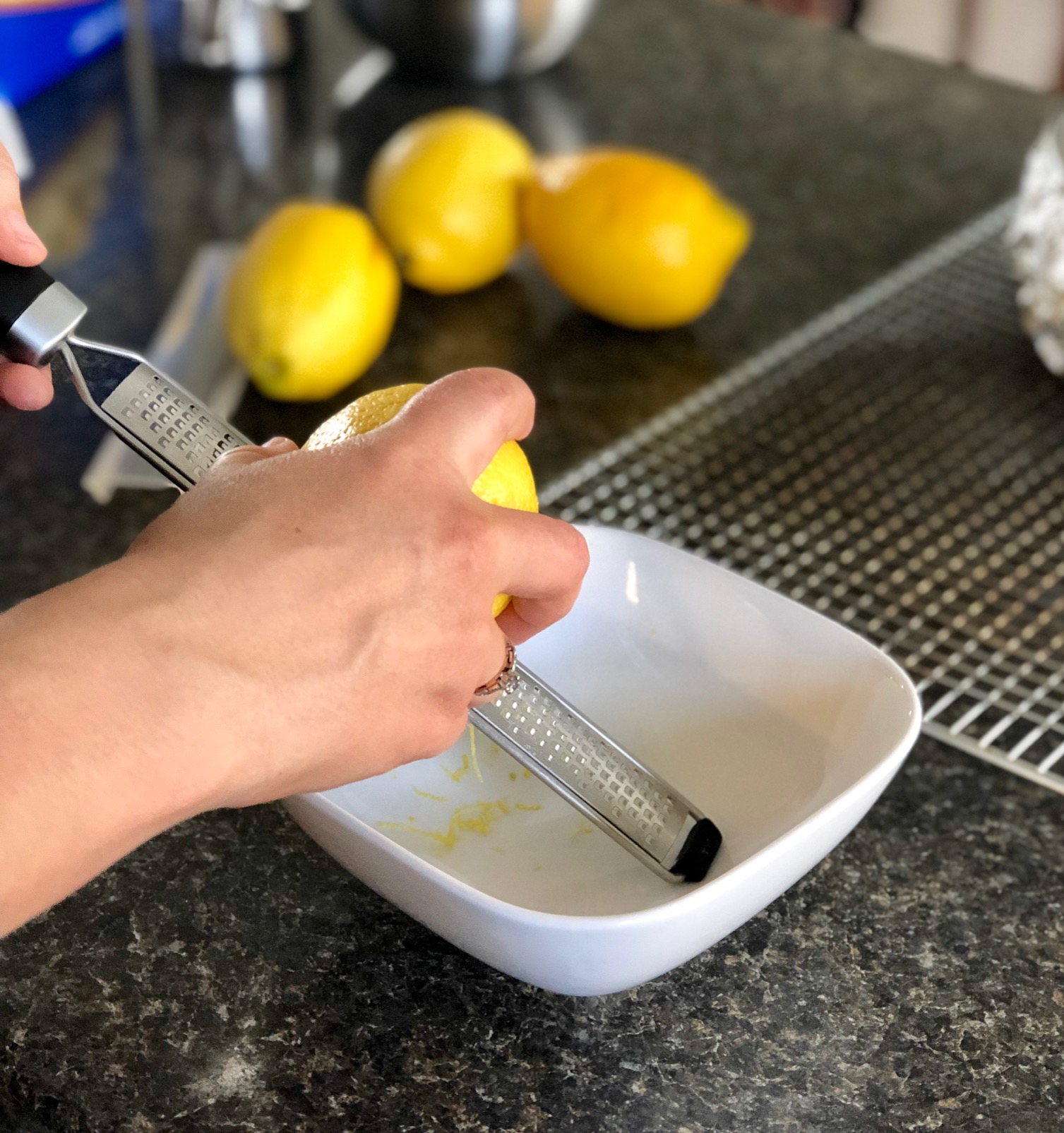

Add the lemon zest and juice to the cream cheese mixture.
This is also when you should add 2 tsp of vanilla. Cream together thoroughly.
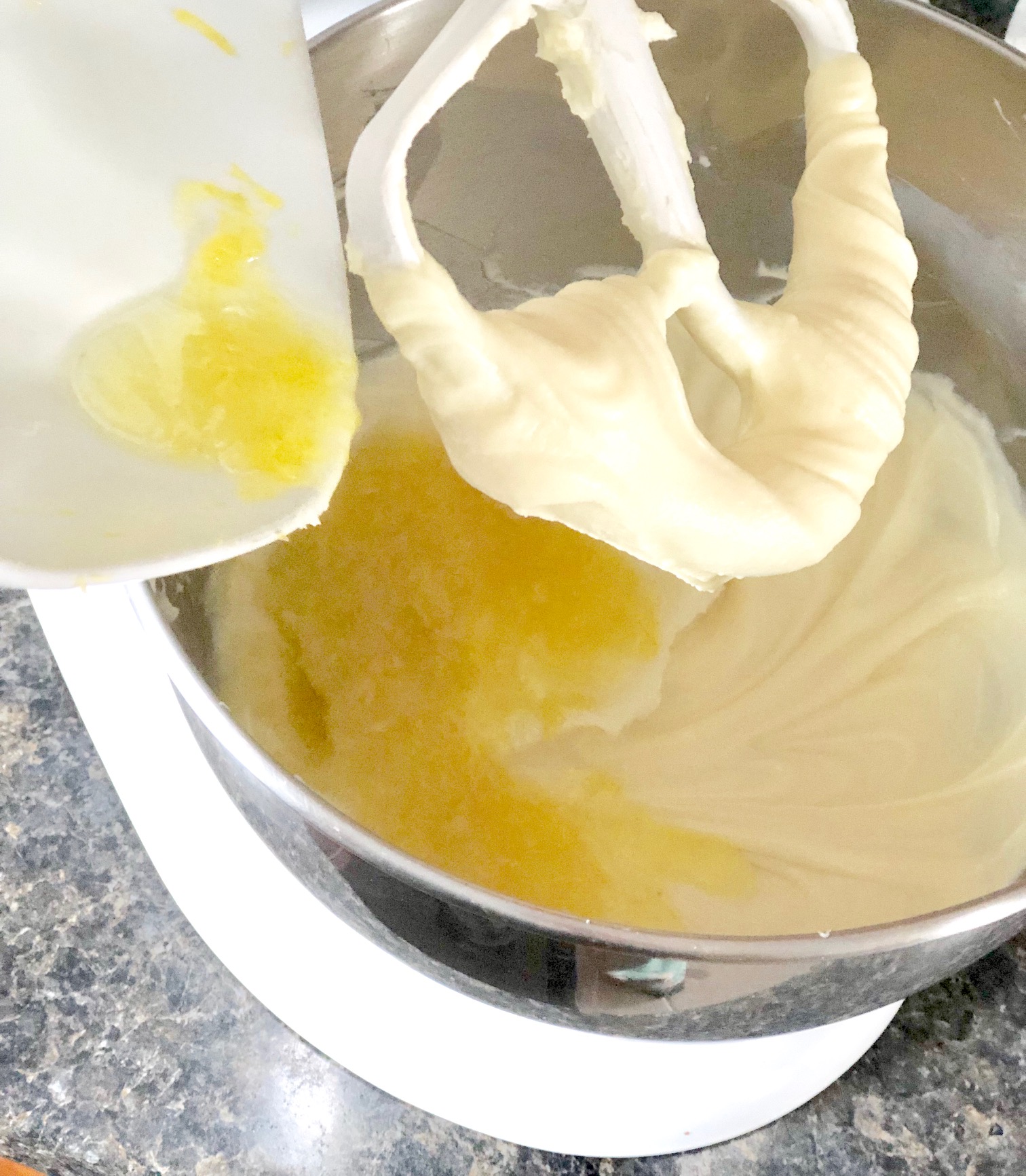
Then add your sour cream and beat on med-low until everything is well incorporated and creamy.
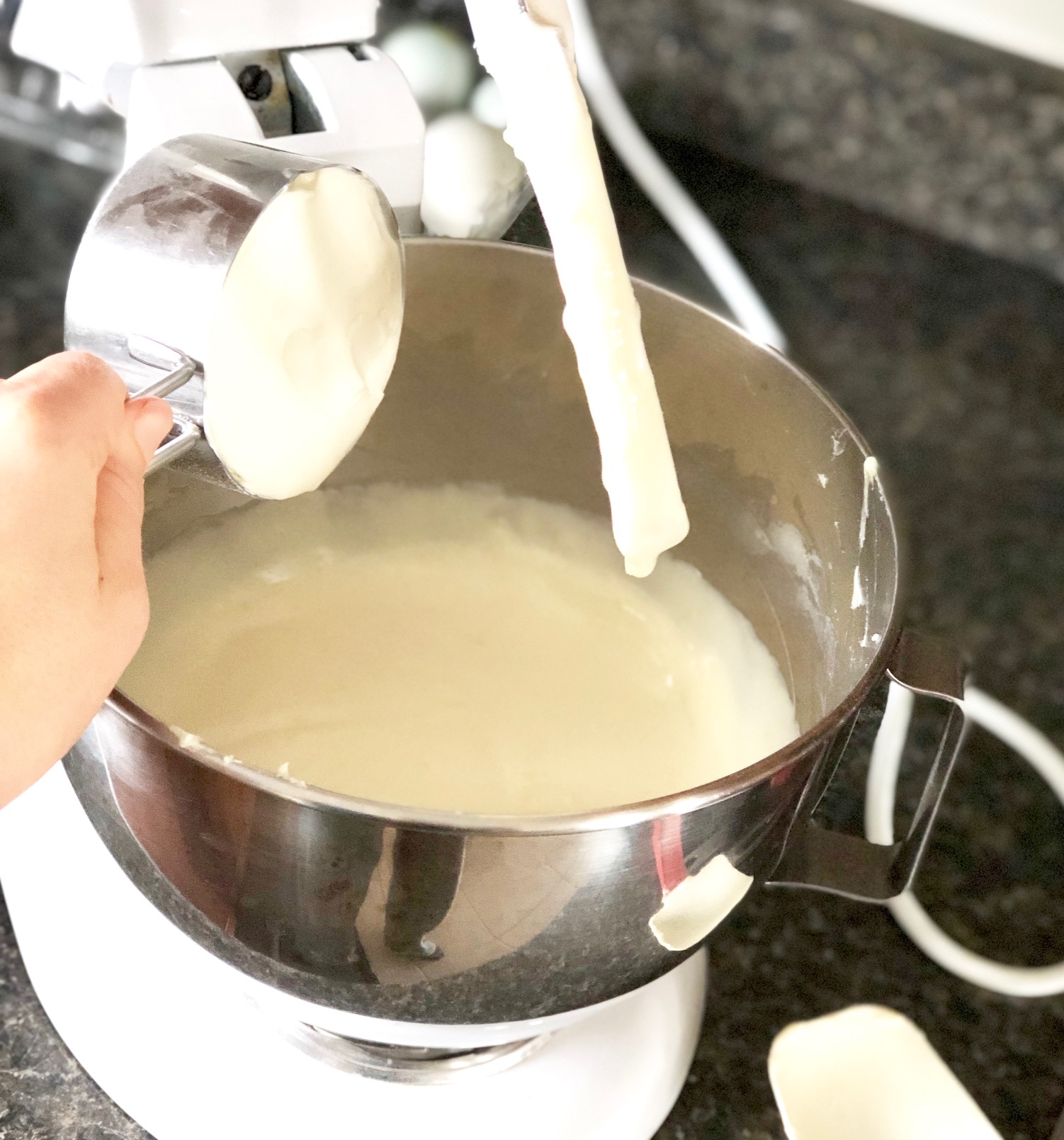
I forgot to take pictures of the next step, which is adding the eggs.
Crack the eggs into a separate, small bowl. With the mixer on medium-low speed add one egg at a time to the batter, waiting until the first egg is just barely incorporated into the mixture before adding the next one. Mix thoroughly to ensure the eggs are well combined.
Remove the bowl from the mixer stand and use a spatula to scrape down the sides and bottom of the bowl. Stir the batter by hand a few times, ensuring everything is as incorporated as possible.
If you see a few unmixed bits of cream cheese in the batter, it’s completely ok! – they will melt into the batter while it’s baking and won’t affect the finished cheesecake.
Pour the batter over the cooled crust.
Ensure the crust and pan are not hot – if the pan is cool enough to handle very comfortably, it’s cool enough to pour the batter over.

Transfer the lemon cheesecake to a large roasting pan (or deep baking dish, big enough to hold it).

Bring a kettle of water to a boil and fill the roasting pan to about an inch (or lower) below the top rim of the springform pan. Be very careful not to splash any water on the cheesecake.
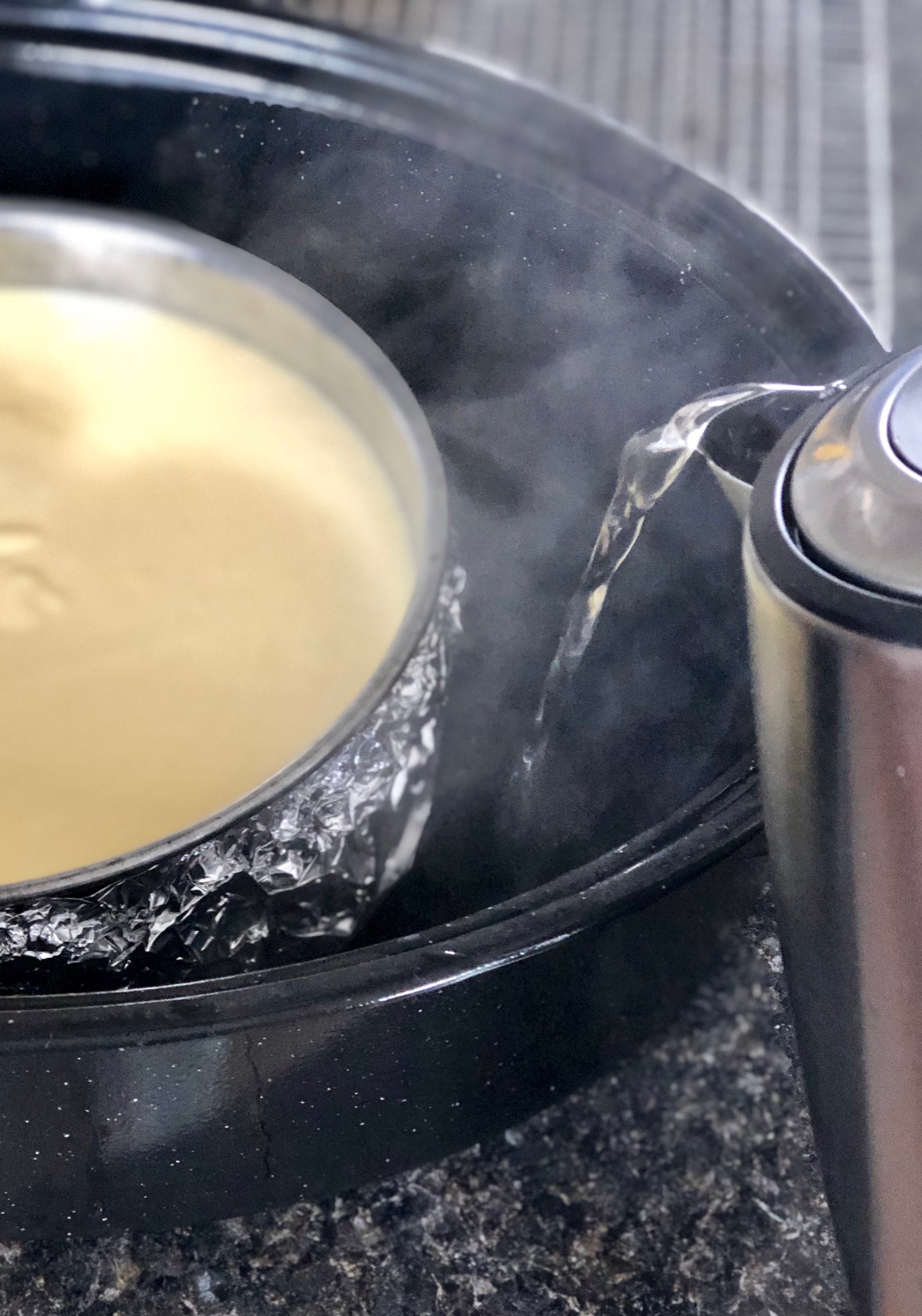
Carefully transfer the roasting pan to the pre-heated oven.
Why bake it in a water bath?
The water bath method bakes the cheesecake gently with steam – you’re basically creating a cheesecake spa! Although the cornstarch (or flour) in the batter should, on its own, protect the cheesecake from cracking during baking, cooking it in a water bath is further insurance that your scrumptious dessert will remain crack-free! The water bath method also makes your cheesecake extra creamy.
Bake for 40-45 minutes. Do not overbake.
If you’re making this recipe in an 8-inch pan, cook for 45 min; if baking in a 9-inch pan, shorten your cooking time to 40 minutes as the cheesecake will not be as thick.
A perfectly cooked cheesecake should have a good amount of jiggle in the center when you gently shake the pan, while the outer inch will be more firm. It should still look somewhat shiny on the surface, with no caramelization or browning.
Turn the oven off, prop the oven door open about an inch or 2, and leave the cheesecake in the oven for an additional 1 hour. Cheesecakes do best when they’re allowed to cool very slowly.
After cooling the oven for an hour, remove the cheesecake from the oven and the water bath. Run a sharp knife around the cheesecake’s edge to ensure it’s not sticking to the sides (which can cause it to crack while cooling). Take the tinfoil off your springform pan and let the cheesecake cool completely on a cooling rack.

Sometimes, a little water gets inside the tinfoil and into the bottom of your pan. DO NOT PANIC! Although the crust may look a little soggy at first, once it’s been chilled in the fridge, it will firm up beautifully, and you’ll be none the wiser! I promise.
Chill the cheesecake, uncovered, in the fridge for at least 4 hours, but ideally, you should chill it overnight.
This step is essential for achieving the perfect cheesecake texture: velvety, creamy, and smooth – don’t rush it.
If you cut into and serve an unchilled cheesecake, you’ll think you’ve done something terribly wrong – the texture will be more like a custard or flan.
When you’re ready to serve your cheesecake, remove the outer ring of the springform pan and oh so carefully, transfer the cheesecake from the springform bottom to a serving platter. This step will reveal if you packed your crust down firmly enough. If you suspect your crust is too crumbly, leave it on the springform bottom for serving.
Spread a generous layer of homemade lemon curd over the top of the cheesecake. The cheesecake will still taste incredible if you don’t have lemon curd!
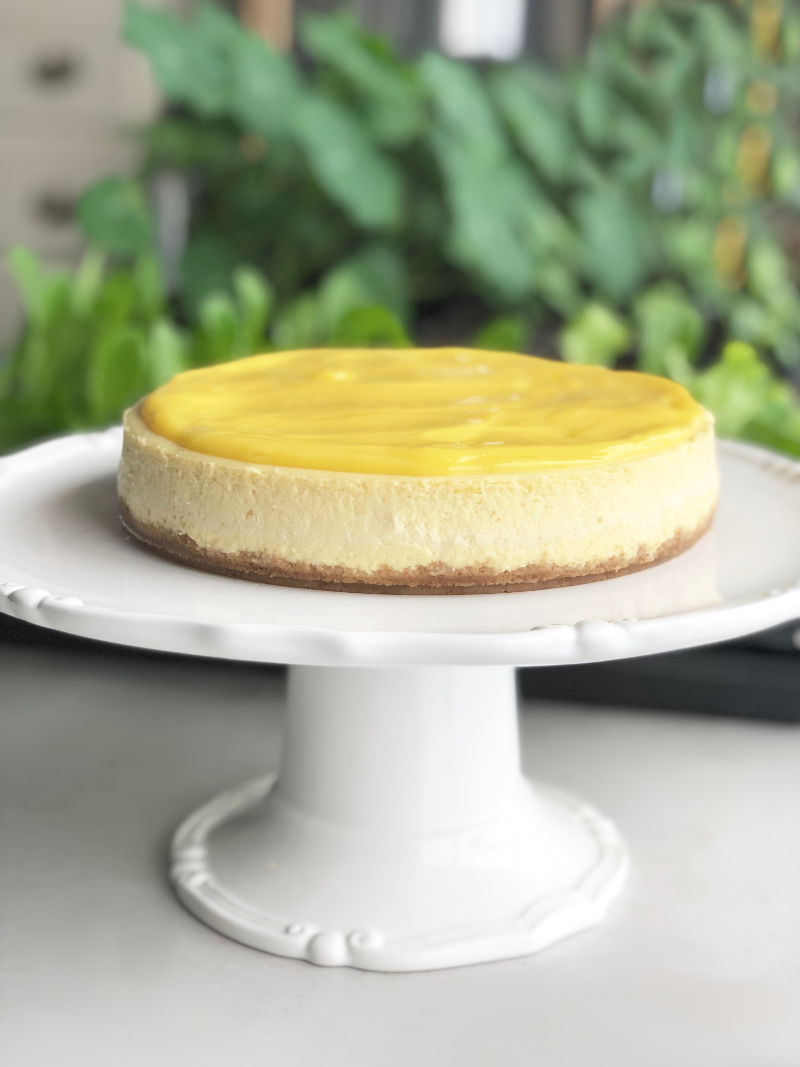
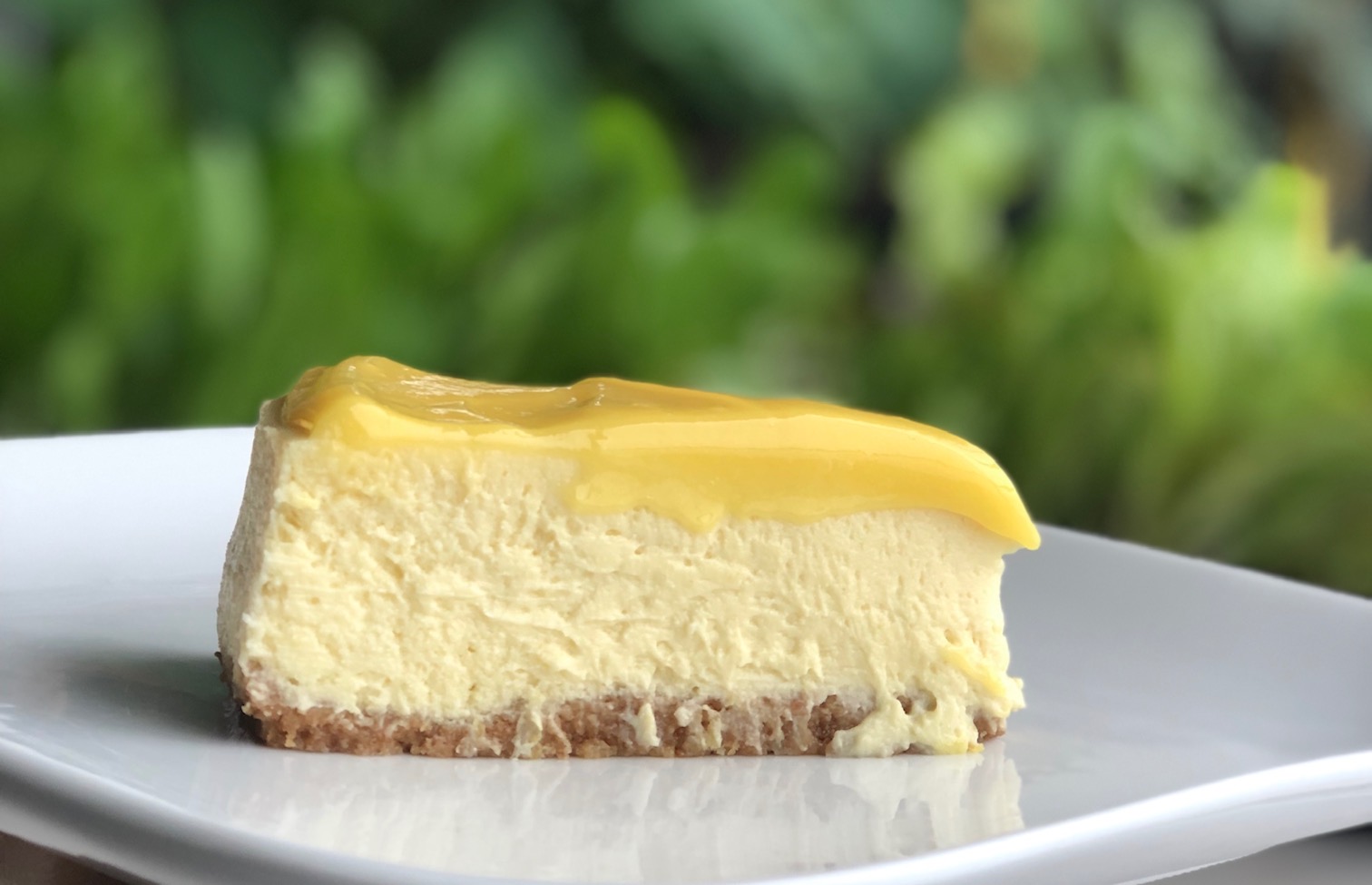
Another delectable addition to this cheesecake is barely sweetened whipped cream… a lovely little dollop on top of each piece is truly delightful.
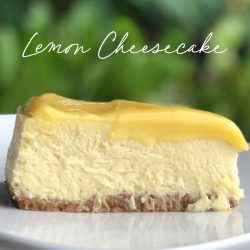
Lemon Cheesecake & Lemon Curd
Equipment
- 8 inch Spring Form Pan
- Electric Beaters or Stand Mixer
- Citrus Zester
- Roasting Pan
Ingredients
Crust
- 6 oz Graham cracker crumbs About 12 whole crackers (For a gluten-free cheesecake, use gluten-free graham crumbs)
- 5 Tbsp melted butter
Filling
- 2 8oz packages cream cheese Softened
- 1 cup white sugar
- 2 Tbsp flour or 1 Tbsp corn starch
- zest of 2 lemons
- 6 Tbsp lemon juice fresh is best!
- 2 tsp vanilla
- 1 cup sour cream
- 2 eggs
Instructions
The Crust
- Preheat your oven to 350° F
- Coat the inside of an 8-inch springform pan with butter.
- Combine the graham cracker crumbs and melted butter in a bowl. The mixture should be the texture of wet sand, and hold together when you squeeze it in your fist.
- Transfer the mixture to the greased springform pan and very firmly press the crumb mixture evenly into the bottom of the pan, using either your hands or the bottom of a drinking glass.
- Bake the crust for 8-10 minutes, until fragrant and golden around the edges. Remove from the oven to a cooling rack.
- Once cool enough to touch, wrap the springform pan with 2 sheets of tinfoil. Cut 2 large pieces of tinfoil and set them on your work surface, one on top of the other in a cross. Set the springform pan in the middle of the foil, and wrap the foil up and around the sides of the pan. Seal the top of the foil as tightly as you can around the top; this helps prevent condensation from forming between the pan and foil and damping your crust.Set the pan aside until the filling is ready.
The Filling
- Place the softened cream cheese, sugar, salt, and corn starch (or flour) in the bowl of your mixer fitted with the paddle attachment (alternatively, you can use a hand-held electric mixer and a large bowl). On medium-low speed (NOT high), cream the ingredients together until creamy and silky and no lumps of cream cheese remain. Use a spatula to scrape down the edges of the bowl making sure everything is well incorporated.
- Add the lemon zest, lemon juice, and vanilla to the cream cheese and mix thoroughly.
- Add the sour cream and beat on medium until well combined.
- Add the eggs to the batter, one at a time, waiting until the first egg is just barely incorporated before adding the next one. Mix fully.
- Remove the bowl from the mixer stand and use a spatula to scrape down the sides and bottom of the bowl. Stir the batter by hand a few times, making sure everything is as incorporated as possible.
- Pour the batter over the cooled crust.
- Transfer the lemon cheesecake to a large roast pan (or baking dish big enough to hold it).
- Boil a kettle of water and fill the roasting pan with boiling water, to about an inch (or lower) below the top rim of the springform pan. Be very careful not to splash any water on the cheesecake.Carefully transfer the roasting pan to the preheated oven.
- Bake the cheesecake in the water bath for 40-45 minutes. Do NOT overbake. Your perfectly cooked cheesecake will still have a good amount of jiggle in the center when you gently shake the pan, while the outer inch will be more firm.
- Turn the oven off, prop the oven door open about an inch or 2, and leave the cheesecake in the oven for an additional hour to slowly start to cool.
- After an hour of cooling in the oven, remove the cheesecake from the oven and from the water bath. Run a sharp knife around the edge of the cheesecake to make sure it’s not sticking to the sides (which can cause it to crack while cooling). Take the tinfoil off your pan and allow the cheesecake to completely cool on a cooling rack.
- Chill the cheesecake, uncovered, in the fridge for a least 4 hours, but ideally, overnight. DO NOT SKIP THIS STEP! This step is extremely important for achieving the perfect cheesecake texture; velvety, creamy, and smooth.
- When you’re ready to serve your cheesecake, remove the outer ring of the springform pan and oh so carefully, transfer the cheesecake from the springform bottom to a serving platter.Spread a generous layer of lemon curd over the top of the cheesecake, or don't – the cheesecake is still incredible without it!




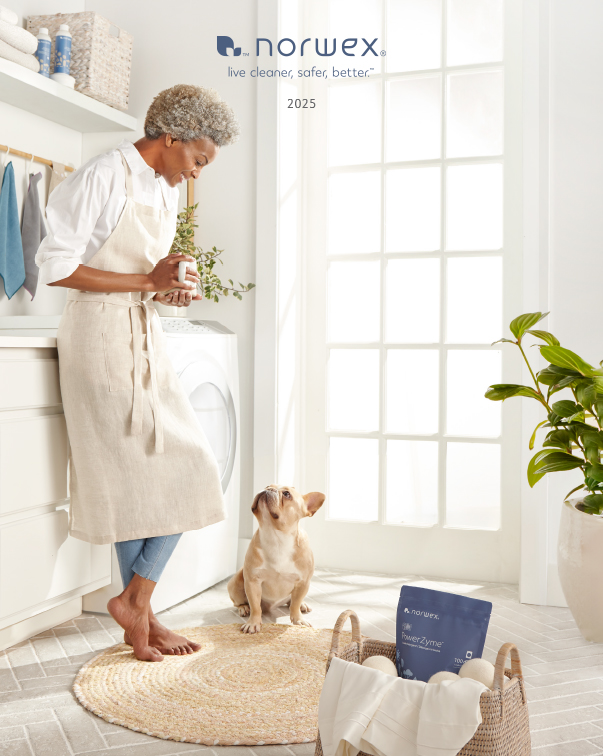
5 star, show stopper & party favourite!!